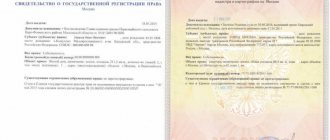Briefly about voluntary separation
Voluntary division of a plot of land in shared ownership has a number of advantages:
- Efficiency. Within a few days you can register property in new shares;
- Saving. Voluntary division of land will cost several times less than a full-fledged trial with examinations, the help of a lawyer and many other problems;
- The ability to settle all the conditions yourself. The court is limited by law. The parties can agree on anything, up to and including providing a share of a car plot or other property instead of the cost.
In any case, the first thing you need to consider is options for voluntary separation. Then, if an agreement cannot be reached, you can go to court and demand a forced division of the plot in court.
What does it mean to divide a plot between owners?
This legal operation is regulated by Art.
11.4 Land Code of the Russian Federation. The division of one land zone into several sectors represents a series of activities to carry out preparatory operations, cadastral work and registration actions aimed at formalizing the division of the site. Plots are considered divided when each area of land territories, after transformation, acquires an independent character, and a single plot, which previously constituted the areas of two new ones, ceases to exist. In this case, the right of common ownership of the formed plots of land passes to the owners of the divided territory.
Without obtaining the approval of all owners of the plot, it is impossible to achieve its legal division. Consent is usually formalized in the form of a division agreement. At the same time, there is another way, which involves obtaining approval for the division of land in court.
Divisible and indivisible land plots
The Land Code of the Russian Federation gives the concept of a land plot - this is the surface of the earth with established boundaries, which are determined based on the norms of land legislation. All registered real estate objects have a cadastral number and are registered in a single register. Land plots are:
| Divisible | Indivisible |
| The size of such lands corresponds to the minimum established in the region | The plots do not meet legal requirements, the dimensions do not comply with established standards, therefore such lands cannot be registered |
Specialist comment Yuri KamenskyLawyerAsk a question to an expert You can divide a property only if it is divisible. Article 1182 of the Civil Code of the Russian Federation states that when a land plot is divided, new ones are formed, which must meet established standards. The formed areas are called secondary.
Standards for plot sizes vary depending on the region of Russia. For example, for the Moscow region the following standards for minimum land sizes have been established:
- 2 hectares for peasants and farmers;
- 0.06 hectares for gardens and country houses;
- 0.04 hectares for garden plots.
Indivisible land plots cannot be divided between owners. When dividing such a plot, spouses have several options for action, which will be discussed below.
A land plot is considered indivisible:
- if there are buildings on it that cannot be crushed;
- if, in the event of a division, access or passage to secondary areas is difficult;
- recognized as bail or under arrest;
- when dividing, it forms uneven, pointed and crooked sections;
- if after the division rational and targeted land use deteriorates.
Before you begin the procedure of dividing a land plot, you should make sure that it is divisible. It is also important to remember that according to the Family Code of the Russian Federation, it is impossible to divide a land plot that belongs to one of the spouses if:
- the plot was in the individual ownership of the spouse even before marriage;
- the land was acquired exclusively with the personal funds of one of the spouses;
- the property was inherited or given as a gift.
Important! If the second spouse fails to prove that the land purchased with the funds of the first spouse was improved by common financial investments during the marriage, as a result of which it increased in price, then he has no rights to claim the property.
Can all land plots be divided?
Like any other piece of real estate, land can be in:
- personal;
- share;
- joint ownership.
If the plot is in personal ownership, then the owner can divide it into several smaller ones individually, independently.
The division of land that is in common (joint) or shared ownership occurs in a completely different way; here the consent of all owners of the land plot is required. If at least one of the owners does not agree to determine the shares and divide the land, it will be extremely difficult or impossible to do this.
For example, three brothers became the owners of a land share by inheritance. Two of them decided to divide the inheritance into three equal parts, but the third brother Yegor categorically disagreed with dividing the land, since he wanted to establish a farm on the inherited land. Persuasion did not help, Egor did not agree to the division, as a result, all three brothers decided to start farming and, subsequently, had a successful joint agricultural enterprise.
Each such plot has its own cadastral number and is included in the unified Land Registry.
All land plots can be divided into:
- divisible, that is, those during the division of which new plots are obtained that fully comply with all the norms of the original one;
- indivisible (when they are divided, new plots do not fit into the declared standards).
Those land plots that are in common (joint) or shared ownership are subject to division.
For example, the N. spouses bought a residential building and the land underneath it with an area of one hectare, registering the entire property as common property. During a divorce, they can divide both the building and the land underneath it, since both are co-owners of the property, and the area of the plot allows it to be divided into two parts.
Not all objects are subject to division; there are some restrictions, both on the form of ownership and on the intended purpose. The division procedure is possible only if each newly created plot does not change its intended purpose.
For example, if a plot intended for individual housing construction is divided, then all newly formed plots must have the same purpose.
Or another example: land that has the status of agricultural land should remain so.
It is impossible to divide the land if, as a result of fragmentation, the area of the individual parts becomes less than the permissible minimum size; these values vary depending on the purpose and status of the land.
For example, there is a land plot for individual housing construction measuring 0.50 hectares. According to the regulations, a plot intended for individual housing construction cannot be less than 0.3 hectares. It is impossible to divide 500 sq.m. so that both plots are at least 300 sq.m., that is, the condition under which division is possible is not possible to comply with. Such an allotment will be considered indivisible.
Even in cases where the land plot meets all the standards and is divisible, it cannot necessarily be divided; everything will depend on its owners. It is impossible to divide an allotment that is the personal property of one of them, that is, if the land was donated, received as a gift or inheritance, or privatized by one of the spouses, then it belongs to him by right of personal property and the second spouse cannot claim it.
Important. If during the period of marriage the land was somehow improved or landscaped using joint funds, as a result of which it significantly increased in price, then the second spouse has the right to a share in the plot proportional to the invested funds.
For example, Oleg K. inherited a dacha plot of land. Subsequently, he, together with his wife Alla, carried out reclamation of the swampy part of the summer cottage, planted an orchard there, built a garden house and a summer kitchen. After the improvements, the value of the land doubled.
A few years later, the couple decided to divorce and divide their joint property. Alla can claim part of the land plot, at a cost equal to half of the funds jointly spent on improving the land.
There are several other conditions under which the division of land is impossible:
- it is impossible to divide the land that is seized;
- if there is no free access to any of the secondary plots, the law prohibits the registration of such a newly created plot.
For example, two co-owners decided to divide land in a river bend. The plot is located in such a way that with any method of division, no matter how the co-owners try, one of the secondary plots turns out to be blocked by the first and the river, that is, it does not have free access. In such a situation, division is impossible.
In cases where it is impossible to divide the land in kind, the co-owners can resolve the issue of division in one of the following ways:
- leave the plot to one of the co-owners, while the one who retains the land must pay the other monetary compensation in the amount of half the cost of the entire plot;
- sell the property and divide the proceeds from the sale;
- leave everything as it is, drawing up an agreement on the use of the land.
Conditions and methods of dividing a land plot
If the spouses have a divisible land plot that corresponds in size to the norms of the region, then the division process will not be difficult.
To implement the division, several conditions must be met:
- Divisible land plot.
- The plots formed from the original one cannot have a size less than that established by the authorities of the subject of the Russian Federation.
- Secondary lands must retain their intended purpose.
- There cannot be any restrictions or prohibitions on the property. If a plot is seized by bailiffs, it cannot be divided. The law also prohibits dividing farm plots.
- The created areas must remain freely accessible.
Without meeting all the above conditions, it is impossible to divide the land.
If the joint property is an indivisible plot, or does not meet the above conditions, the cadastral authority will refuse to supply the formed plots for registration.
When establishing the indivisibility of a plot, owners can do the following:
- Leave the property to one of the owners, and compensate the second with money. The amount of compensation must correspond to half the value of the property.
- Sell the property and divide the proceeds from the transaction in half.
- Do not divide the plot, leaving it in joint use, while defining the order of use.
You can divide joint property:
- in a legal way;
- voluntarily.
Legal division of a plot involves division based on legal requirements - in equal shares. If the land is indivisible, the court will determine the amount of monetary compensation. The spouse who remains the owner will pay the money to the second spouse. If during the trial it turns out that part of the property was sold or donated by one of the spouses, then the requirement for division is added to the requirement to invalidate the earlier transaction.
Comment from an expertLeonov VictorLawyerAsk a question to an expertThe voluntary division procedure involves drawing up an agreement, which will become the basis for registering the right in Rosreestr. The procedure and conditions of the section are determined by the document. The agreement is made in writing.
Drawing up an agreement on the division of a land plot
The document is drawn up by the owners voluntarily, in writing. You can draw it up yourself or seek help from a lawyer. The law has approved the form of the agreement. The document must be certified by a notary, and only then contact the registration authorities. The execution of the agreement requires the consent of all property owners.
The text of the agreement on the division of a land plot must contain the following information:
- owner details (full name, passport details, residential address);
- address of the divided land plot;
- name and registration number of the document establishing rights to a plot of land;
- cadastral number and date of registration of the site in the Unified State Register of Real Estate;
- information about the voluntary consent of the spouses to the procedure for dividing the plot;
- conditions of division, shares of owners, sizes of secondary plots;
- the procedure for bearing costs for the division procedure between the parties;
- place of detention;
- date of;
- signatures of the parties.
The agreement certified by a notary should be submitted to the territorial department of local government that deals with these issues. There the document will be certified, after which you can go to Rosreestr to register your rights.
Commentary by an expert Kolesnikova AnnaLawyerAsk a question to an expert When spouses cannot reach a mutual agreement, they turn to the court to resolve the issue of dividing a land plot.
What needs to be done before dividing land (dachas, private plots, etc.)?
Before contacting the relevant authorities to formalize the division of territories, citizens must take the following actions:
You can find more complete information on the topic in ConsultantPlus. Full and free access to the system for 2 days.
- Confirm the availability of papers regulating the boundaries of the original territory to be divided. You should find out whether this area has undergone a land surveying procedure. In cases where the land has not been surveyed or the standard accuracy of determining the boundaries of the zone is lower than that established by law, it is necessary to begin preparations for cadastral work. They will allow you to identify the boundaries of the site with maximum accuracy and determine its total area.
- Clarify the location of characteristic points of the original land plot. If their exact location is unknown, the boundaries of the site should be determined.
- Conclude an agreement on the division of a land plot, the terms of which must be discussed in advance. The agreement on the division of land must stipulate into which plots the former object is divided and to whom ownership they pass.
Preparation for the actual division of the site
Preparations for the actual division of land include a number of activities, including:
- obtaining a cadastral extract from the State Real Estate Cadastre for the original plot;
- obtaining a cadastral plan of the territory (see: How to obtain a cadastral map and land plot plan online?);
- familiarization of the cadastral engineer with the title papers for the original plot of land;
- assessment of the location of neighboring lands, identifying the exact location of characteristic points of the original zone in order to avoid crossing borders;
- establishing the need for field work, which is determined based on the conclusion of the geodetic team.
When is land not divided between husband and wife? Ownership
When is land not divided between husband and wife? Ownership
Even if the land plot is divisible and complies with all cadastral norms, this does not mean that it is subject to division between husband and wife. It all depends on who it belongs to. Only if the land is jointly owned can it be divided.
Land is not divided if it belongs only to one of the spouses as personal property - it was privatized, received as a gift, inherited, or purchased with personal funds. If the land has not been improved, landscaped, or ennobled by both spouses using common marital funds during the marriage, it remains personal property and is not subject to division.
It is a completely different matter if the land was personal property (for example, it was acquired before marriage, privatized, inherited, received as a gift), but increased in value thanks to the investment of funds and efforts of the second spouse during the marriage. Then the second spouse has the right to part of the land plot.
Decision on division of land
According to Article 43 of the Land Code of the Russian Federation, the owner of a land plot has the right to conduct any transactions provided for by law with it at his own discretion. In particular, divide it into several new plots. The reasons for the division can be any: sale, donation, lease of one of the newly formed plots.
For example, if a divisible land plot belongs to one of the spouses by right of personal property (and, therefore, is not subject to division during a divorce), he may decide to divide the land into several parts and transfer one part to the second spouse.
After the division procedure and state registration, each of the newly formed land plots will become an independent piece of real estate.
The legislation does not establish a maximum number of new plots that will arise as a result of the division. The only limitation is established by Article 33 of the Land Code of the Russian Federation - the area of newly formed plots should not be less than the minimum area for a land plot for a specific purpose (construction, agriculture, gardening, etc.), as already mentioned above. It should also be noted that the intended purpose after the division will remain the same as it was before the division.
If there is only one owner of the land, there is no need to draw up agreements with other co-owners. The division procedure is carried out without any legal difficulties, subject to strict compliance with the norms of the Land Code and other legislative acts. Thus, the division is preceded by land surveying, assignment of cadastral numbers and registration of cadastral documents for new plots.
In addition, the division procedure requires proper documentation - in the form of the owner’s decision on the division of the land plot. This document, essentially a one-sided transaction, is a title document and the basis for state registration of ownership of newly formed real estate.
Requirements for a plot of land
Before starting the procedure for dividing a plot, you need to make sure that the land can be divided. To do this, the area to be divided into parts must meet the following requirements:
- Have permissible maximum and minimum sizes - they are regulated by acts of regional authorities. When determining the size of land, officials are guided by the norms of civil, land and urban planning legislation. Land areas depend on their functional purpose.
- The boundaries of land zones should not intersect with the boundaries of settlements and municipalities.
- Lands cannot be divided if certain encumbrances are imposed on them that limit the limits of their use.
- It is prohibited to carry out division of territories, which may have consequences in the form of the formation of broken borders, mixing of the boundaries of different land plots, or the wedging of one territory into another. The law also warns land owners that the division of land should not become an obstacle to the protection of land and its rational use.
The legislation also prohibits the division of land, which may provoke a change in their category. It is also prohibited to transform zones in cases where such changes entail a violation of urban planning standards.
Land plot: divided or not divided?
Land plot: divided or not divided?
The Land Code of the Russian Federation defines a land plot as a part of the earth's surface with established boundaries. The boundaries of land plots are established by specialized bodies in accordance with land legislation. The plots are described, individualized, given a special cadastral number, and entered into the unified Land Cadastre.
Land plots are divided into...
- divisible - those whose dimensions correspond to the minimum standard for a site for a specific purpose within a specific region of the Russian Federation;
- indivisible - those that do not comply with the above standards, which means they cannot be registered in the cadastral register.
A plot can only be divided if it is divisible. According to Article 1182 of the Civil Code of the Russian Federation, when dividing a divisible plot, new plots must be formed that meet the standards for a plot of a certain purpose.
As mentioned above, the standards differ depending on the region of the Russian Federation. For example, residents of the Moscow region are provided with ownership of plots of the following minimum sizes:
- for peasant and farm enterprises - 2 hectares;
- for garden and summer cottage plots - 0.06 hectares;
- for a vegetable garden – 0.04 hectares.
If the spouses have a divisible land plot in joint ownership that complies with the above standards, there should be no difficulties in dividing it.
In addition, there are other conditions for the division of land:
- The land plot must be divisible.
- Secondary land plots must be no less than the minimum size established by self-government bodies in a certain region of the Russian Federation.
- Secondary land plots must retain the designated purpose category.
- There should be no prohibitions or restrictions imposed on land by law. For example, according to the Federal Law “On Farming” it is prohibited to divide land intended for farming. Land that is seized cannot be divided.
- Secondary land plots must have free access, otherwise division is also impossible.
If the joint land is indivisible (or does not meet the other listed division conditions), it cannot be divided - the Land Registry Authority will refuse to register the newly formed plots.
In this case, the spouses may come to the following:
- leave the land to one spouse, and pay the second spouse a monetary compensation equal to half the value of the land;
- sell the land and divide the proceeds;
- leave the land in joint ownership and determine the procedure for use.
Example 1
In the third year of family life, the Rozanovs became heirs to a plot of land with an area of 0.14 hectares, which was located on the territory of a garden partnership. According to the will executed by the husband's grandmother, the spouses received equal shares. When the Rozanovs decided to divorce a year later, the issue of dividing the land was resolved as follows: the spouses entered into a written agreement, according to which a real division was made into two equal plots of land. This is how the termination of shared ownership occurred, the husband and wife became the sole owners of two newly formed plots.
Example 2
The Loginov couple bought land to build a country house, but the construction remained unfinished - the husband and wife decided to end their marital relationship. It turned out that a real division of the plot into equal parts was impossible due to the building erected on it. The couple did not initiate legal proceedings, but agreed peacefully: the land with the unfinished building became the property of the husband, the husband paid the wife monetary compensation equal to the estimated value of her share.
Agreement on determining shares
“Civil Code of the Russian Federation (Part One)” dated November 30, 1994 N 51-FZ (ed.
from 07/29/2019) (with amendments and additions)
entry in force from 06.08.2019) 2.
An agreement by all participants in shared ownership may establish a procedure for determining and changing their shares depending on the contribution of each of them to the formation and growth of common property. A Guide to Corporate Litigation.
This is interesting: How to behave in the traffic police during analysis
Issues of judicial practice: Withdrawal of a participant from a limited liability company 2.8.
An agreement to determine shares is an agreement concluded between two or more persons who have any property in common joint ownership. As a rule, an agreement to determine shares is concluded in relation to a real estate object (apartment, residential building, land plot).
The determination agreement is aimed at voluntarily regulating property relations between owners of common joint property.
Main stages of the section
Of course, you can’t just go out onto a plot of land, draw some kind of line on it dividing the land in half and then decide that a division has occurred. Before it becomes divided into several separate ones, it is necessary to go through several stages:
- Make sure that the partition is possible. Co-owners of land should inquire with the local municipality about the minimum permissible sizes of newly formed plots and compare the standards with the sizes that they plan for division.
- Check the availability of all title documents for the plot planned for division (whether cadastral registration has been carried out, whether boundaries have been established, etc.). If any documents are missing or they are not in order, eliminate the identified deficiencies.
- Write a statement (agreement) about the division. The document must be certified by a notary office.
- Create a draft section. In the future, the land will be divided in accordance with this project. It must be remembered that the physical characteristics of the plots, the possibility (or impossibility) of its division in accordance with the law, that is, the real division, will depend on how the cadastral engineer draws up the project.
- Submit the project to the local cadastral registration authorities. Employees of this organization will record data on each secondary plot and enter it into the cadastre. All changes will be temporary until each owner undergoes state registration of real estate.
- Obtain a certificate of registration from Rosreestr. Each owner must do this, otherwise, after five years, all temporary changes in cadastral registration will be canceled.
What to write in the separation agreement?
An agreement on the voluntary division of a land plot between owners must contain the following information:
- personal data about all owners of divisible real estate (full name, information about place of residence, passport number and series);
- information about the shares owned by each co-owner;
- details of the entry in the Unified State Register of Rights to Land, the grounds for its occurrence;
- location of the land plot;
- cadastral number of the plot;
- method of division of real estate approved by all owners;
- data confirming consent to the division of property given by all parties to the agreement;
- reflects the procedure for terminating common shared ownership after state registration of new plots is carried out;
- the absence of encumbrances on the site from third parties, as well as encumbrances in the form of a pledge or arrest, is indicated.
- the moment of emergence of ownership of the divisible plot;
- determining the method of payment for expenses associated with the division of property;
- grounds for the entry into force of the signed document;
- obligations to perform all actions provided for in the agreement;
- place of drawing up the agreement;
- date of endorsement of the document and signatures of all parties to the transaction.
Required documents
When drawing up a contract, you must have a package of documents:
- passport;
- title documents for land (agreement, certificate of inheritance or others);
- cadastral passport, extract from the Unified State Register;
- receipt of payment of state duty.
After completing the agreement, you must contact the Rosreestr office or the MFC, since government agencies must record the redistribution of land shares between owners.
Is the agreement notarized?
The legislation does not regulate a direct rule that would provide for the obligation of owners to notarize an agreement. However, such actions will not be superfluous if any of the parties changes their mind and refuses the deal, which will help avoid lengthy legal proceedings.
Also, the parties may require notarization of the transaction in case the procedure for registering rights under the agreement is postponed for a long time.
Any land owner has the right to insist on notarization of the concluded agreement.
Today, such a document is subject to state registration in Rosreestr and cadastral registration in the corresponding cadastral division of Rosreestr.
At the same time, the signed agreement on the division of real estate is subject to mandatory endorsement at the territorial branch of the administrative body located at the location of the divided plot, whose powers include carrying out these actions.
Procedure for registering an agreement
An agreement on the division of a land plot is not subject to state registration in a separate manner.
However, it is included in the list of necessary documents that should be submitted to the Rossreestr authorities to register ownership of newly created land plots.
So, to carry out this procedure you will need to collect the following papers:
- personal identification documents of all plot owners;
- application for registration of a plot of land for cadastral registration and registration of property rights to newly created land plots;
- conclusion of the local administration on assigning addresses to new sites;
- land survey plan;
- agreement between property owners on its division;
- documents confirming ownership of the divisible plot;
- confirmation of payment of state duty (optional).
Before applying to register the transfer of rights under a land division agreement, it is better to consult an experienced lawyer.
He will tell you the main composition of the documents and help you determine their list. It is also advisable to ask the question to representatives of Rosreestr at your place of registration.
Expenses
State registration of property rights to new land plots requires payment of a state fee. The obligation to present a receipt is not required by current law, but is the preferred course of action.
This is due to the fact that if there is no information about the payment of the specified tax in the State Information System, the submitted package of documents can be returned to the applicant within five days from
According to paragraph 22 of Art. 333.33 of the Tax Code of the Russian Federation, the fee for individuals wishing to legalize ownership of real estate is two thousand rubles.
There may also be additional costs for making copies of documents.
In general, compared to court proceedings, division of a land plot by agreement is much cheaper than forced proceedings.
AGREEMENT
We, gr. residing at the address: , passport series No., issued, etc. , residing at the address: , passport series No., issued, being participants in common shared ownership of a land plot with a total area of sq. m. m with cadastral number, category of land, permitted use of the land plot, with the total area of sq. m located on it. m, outbuildings and structures, located at the address: , collectively referred to as the “Parties”, have entered into this agreement as follows:
- The specified land plot at the time of signing this agreement is in common shared ownership, is not encumbered by the rights of third parties, is not mortgaged, is not in dispute and is not under arrest (ban).
- Gr. owns a share in the common ownership right to the specified land plot on the basis of which is confirmed by an entry in the Unified State Register of Rights to Real Estate and Transactions with It No. dated "" 2020 Gr. owns a share in the common ownership right to the specified land plot on the basis of which is confirmed by an entry in the Unified State Register of Rights to Real Estate and Transactions with It No. dated "" 2020.
- Due to . The parties agreed to change the shares in the right of common ownership of the specified land plot - to increase the share of gr. and accordingly reducing the share of gr. .
- Guided by Art. 245 of the Civil Code of the Russian Federation, the Parties hereby redistribute shares in the right of common ownership as follows:
- gr. — shares in the right of common ownership of a land plot;
- gr. - shares in the right of common ownership of a land plot.
- This agreement contains the entirety of the agreements between the Parties with respect to the subject matter hereof and supersedes and invalidates all other considerations or representations that may have been accepted or made by the Parties, whether oral or written, prior to entering into this agreement.
- The Parties' shared ownership of the specified land plot in the shares established in clause 4 of this agreement is subject to mandatory state registration in the Unified State Register of Rights to Real Estate and Transactions with It. The parties bear registration costs in proportion to the size of the share in ownership.
- Changes to the terms of this agreement, its termination and termination are possible only by written agreement of the Parties.
- On all issues not covered by this agreement, the Parties are guided by the current civil legislation of the Russian Federation.
- This agreement is drawn up in 3 copies, one of which is kept and a copy is issued to each of the Parties.
This is interesting: State duty for peasant farm registration
Requirements for division
Requirements for division
To reorganize plots, mandatory registration of land real estate ownership is required. Moreover, if there are several participants in the ownership, each is required to be allocated a proportionate share in the right, no less than the minimum size of the land plot.
Common joint ownership differs from shared ownership in that in this case each copyright holder uses the entire plot as his own and has equal rights with the co-owners to the entire area of the land plot.
Redistribution of shares in the right of common shared ownership
Practice shows that usually a private house and plot are owned by several people, not just one. Such real estate is registered in common shared ownership - for example, simultaneously for parents and children. The shares are distributed in different ways - in the same or in different proportions. Over time, shareholders may intend to change the size of their shares. In this case, they will need to draw up an agreement on the redistribution of shares in the common shared property .
This is important to know: Allocation of shares to children after repayment of the mortgage with maternal capital
How to register a right in Rosreestr
The law establishes that cadastral registration and state registration of rights are carried out during the division of land simultaneously. To do this, submit an application in the prescribed form and the following documents to Rosreestr:
- title documents for land;
- applicants' passports;
- agreement of owners (or court decision);
- boundary plan;
- decision of the local administration to assign addresses to established landholdings;
- receipt of payment of state duty.
Resolving situations with indivisible plots
First of all, if a situation arises during which it becomes necessary to carry out the divorce process, it is necessary to establish the fact of divisibility and indivisibility of jointly acquired property, since not all real estate objects are subject to mandatory alienation. The property cannot be divided if it belongs only to the husband or wife, if it:
- was the individual property of one of the spouses before the wedding (Article 36 of the RF IC);
- purchased with the personal funds of the husband or wife (Article 34 of the RF IC);
- was given (or inherited) to one of them.
If the second spouse does not prove that the land acquired with the funds of the other was improved with common funds during the marriage, and therefore increased in price, then he has no right to claim it.
Minimum storage size for partitioning
Minimum storage size for partitioning
Of significant importance in determining the divisibility of a plot is its total area, in relation to the number of owners wishing to allocate their share. That is, after division, each resulting plot must be no less than the minimum size established in a given locality.
According to the provisions of Federal Law No. 136-FZ of October 25, 2001, the local government authority is obliged to determine the minimum size of a full-fledged plot by specially adopted municipal decree. In each region, an acceptable allotment area is established, recognized as the minimum sanitary standard. In most regions it is:
- 4 acres for land in populated areas;
- 6 acres for agricultural land, except in cases of organizing farms;
- 20 acres for running an agricultural business.
It is unacceptable to reduce it. A plot of smaller size will be considered incompetent unless otherwise provided by municipal or federal legislation.
Additional requirements when dividing one land plot into three or more plots
Additional requirements when dividing one land plot into three or more plots
If the reorganization involves the allocation of three independent plots or more than three from one plot, then the original lands must correspond to the sum of the minimum sizes in the number of allocated plots, or exceed them. In addition, in this case additional requirements come into force:
- The original area must have smooth boundaries to prevent them from overlapping during reorganization. And also to determine the exact shares of copyright holders.
- Each emerging land plot must have a convenient separate passage to the common land area and be provided with its own entrance to the site, in order to avoid disputes between future neighbors.
If the original land plot does not provide such opportunities, the division will not be carried out.
If the administration refuses to divide it into the required number of owners, the co-owners can voluntarily reduce their number if some of them buy out their shares from others.
Capital and non-permanent buildings on the territory
If there is a house on the territory, then conclusions about the divisibility of the plot are largely based on whether the building itself can be divided. Parts of a building can be isolated if:
- each half of the house has its own exit to the street;
- each part of the building has a separate electrical panel and an autonomous power supply and heating system;
- the building has several window openings for natural lighting of the room and utility rooms;
- the entire building and its separate parts comply with sanitary standards.
If the house cannot be divided in kind, the owners usually draw up an agreement that one of them becomes the owner of the building, and the rest receive monetary compensation. Even in the case of construction of an object within the framework of shared construction, its actual division is impossible without carrying out appropriate technical expertise.
If a building is divided into a plot, the building is first divided, and only then each owner is allocated the most suitable part of the territory.
Arbitrage practice
There are cases when spouses do not come to a common decision. In such situations, they go to court.
It takes a lot of time to prepare the necessary documents and initiate legal proceedings; in some cases, it happens that by the time the case of division of property is considered by the court, some part of the jointly acquired property is sold or donated by an unscrupulous spouse. In such cases, the requirements for division are supplemented with the requirement to invalidate the transaction for the alienation of the plot or part thereof.
What does redistribution of shares in common shared ownership mean?
The essence of the agreement on the redistribution of shares is as follows: initially there is an object of common ownership, that is, several owners own part of an apartment, house or land plot. They may own unequal or equal shares. By mutual agreement, shareholders have the right to change the size of their shares and dispose of them at their own discretion, but with the permission of the others.
A document can be drawn up if the most important condition is met: all parties agree to the redistribution of shares, there are no disputes. Resistance from at least one of the co-owners gives grounds to go to court. The plaintiff will have to justify why he deserves a larger share, and the court may make one of the following decisions:
- satisfy the claim and determine the size of shares in accordance with the plaintiff’s requirements;
- refuse to satisfy the claim;
- award one of the parties payment of monetary compensation towards the cost of the share or part thereof.
This is important to know: Demolition of part of a house in shared ownership
The legal process takes a lot of effort and time, so it is better to find a compromise than to make enemies in the form of neighbors.
The main stages of dividing a land plot
The standard procedure for the legal and actual division of an allotment consists of several stages, characteristic of all types of ownership (shared and individual).
Surveying
A mandatory step when dividing a plot. It is necessary to verify the actual boundaries of the plots. Land surveying must be carried out by a professional cadastral engineer with the appropriate certificate.
Read more about what land surveying is and why it is needed.
Land surveying can take place desk-based or with a specialist visiting. In the first case, the owners themselves draw the proposed boundary on the old plot plan. Then the division of the site is carried out on the basis of area characteristics, and the actual division of the territory is carried out after receiving cadastral numbers. Only then does a cadastral engineer come to the site and place land boundary markers based on registration data. This method is convenient if you do not need to accurately determine the configuration of the site and boundaries on the ground.
Otherwise, it is better to initially invite a cadastral engineer to measure the divided territory. Then the specialist carries out technical measurements on the ground, checking them with theoretical data, and then prepares a boundary plan for the location of new plots of land, their shape and area.
This process must take place in the presence of all co-owners of the property or their representatives, so that it is possible to divide the territory according to actual use, for example, based on installed fences and other barriers. The approved completed boundary plan is temporarily placed in electronic storage.
Address assignment
After completing the land surveying procedure, you should contact the municipality to obtain the addresses of new objects. The assignment procedure lasts no more than 18 days, after which the applicants are given a corresponding decision.
Cadastral registration and registration
The Land Code provides for the simultaneous deregistration of a large plot of land and the registration of the resulting real estate objects. This procedure is carried out by Rosreestr. You can submit documents to one of the branches of the registration authority, but it is much more convenient to do this through the MFC or the government services website. The cost of the state fee will not change in any way depending on the application submission option and will be:
- 350 rub. for each newly formed plot of individual housing construction and private plots;
- 350 rub. for lands of all other categories.
Registration of the transaction takes place within 10 – 12 working days. After this period, new land plots appear, information about which is confirmed by an extract from the Unified State Register of Real Estate.
Required documents
When registering the division of an allotment, a complete documentation set is submitted:
- passports of all participants in the transaction;
- application (the form can be downloaded in advance on the Internet);
- title documents for land;
- decision on assigning addresses to new real estate objects;
- a division agreement, a single owner's decision, or a court order;
- boundary plan or its identification number in electronic storage;
- confirmation of payment of state duty (documentary or electronic format);
- power of attorney, if one of the co-owners acts through a representative (a sample is taken from a notary).
Taxation nuances
The moment of emergence of ownership of new plots will be the date of state registration of a large plot. Therefore, all legal issues related to taxation when selling and donating real estate are calculated based on the date in the first certificate.
Sources
- https://allo-urist.com/soglashenie-o-razdele-zemelnogo-uchastka-mezhdu-sobstvennikami/
- https://lawinfo24.ru/family/razdel-imushhestva/soglashenie-o-razdele-zemelnogo-uchastka
- https://ros-nasledstvo.ru/soglashenie-o-razdele-zemelnogo-uchastka-mezhdu-sobstvennikami/
- https://law-divorce.ru/soglashenie-o-razdele-zemelnogo-uchastka-obrazets/
- https://ros-nasledstvo.ru/soglashenie-ob-opredelenii-dolej-na-zemelnyj-uchastok/
- https://FreeLawyer.guru/zemlya/razdel-zemelnogo-uchastka.html
- https://how2get.ru/home/priusadebnoe-hozyajstvo/kak-razdelit-zemelnyj-uchastok-na-dva-uchastka/
- https://lawowner.ru/nedvizhimost/zemlya/soglashenie-o-razdele-uchastka
[collapse]







